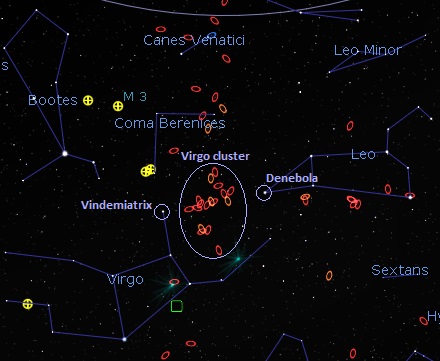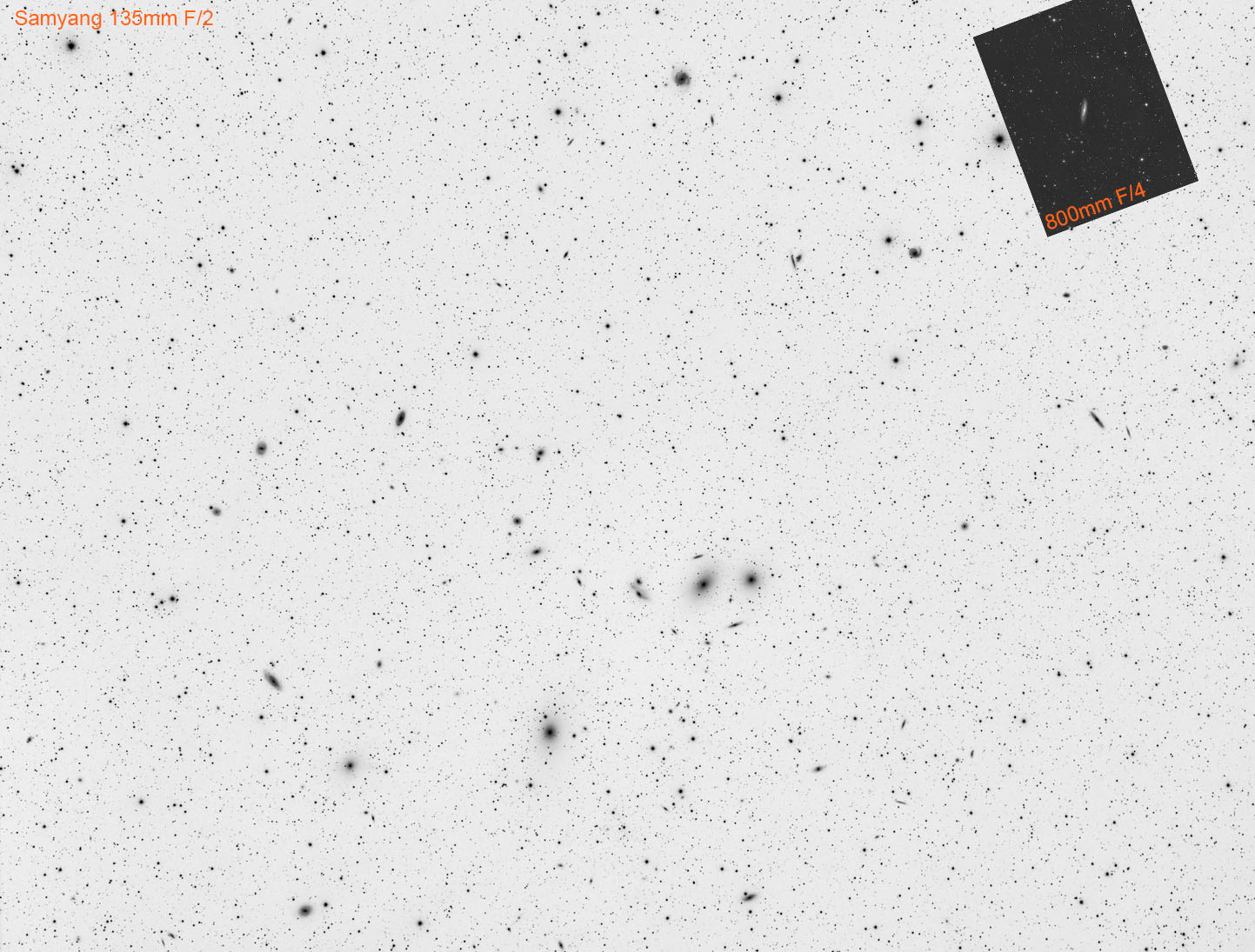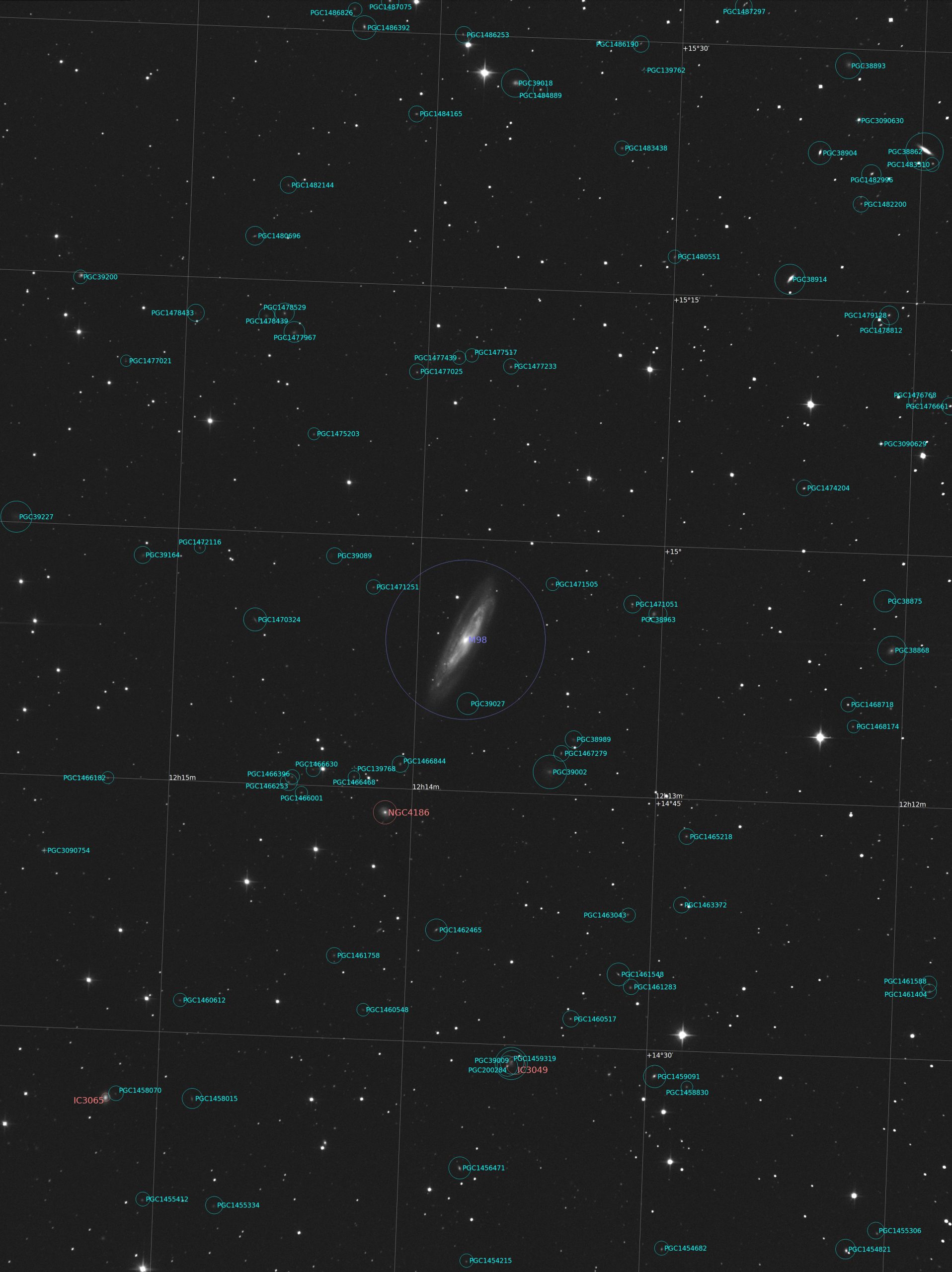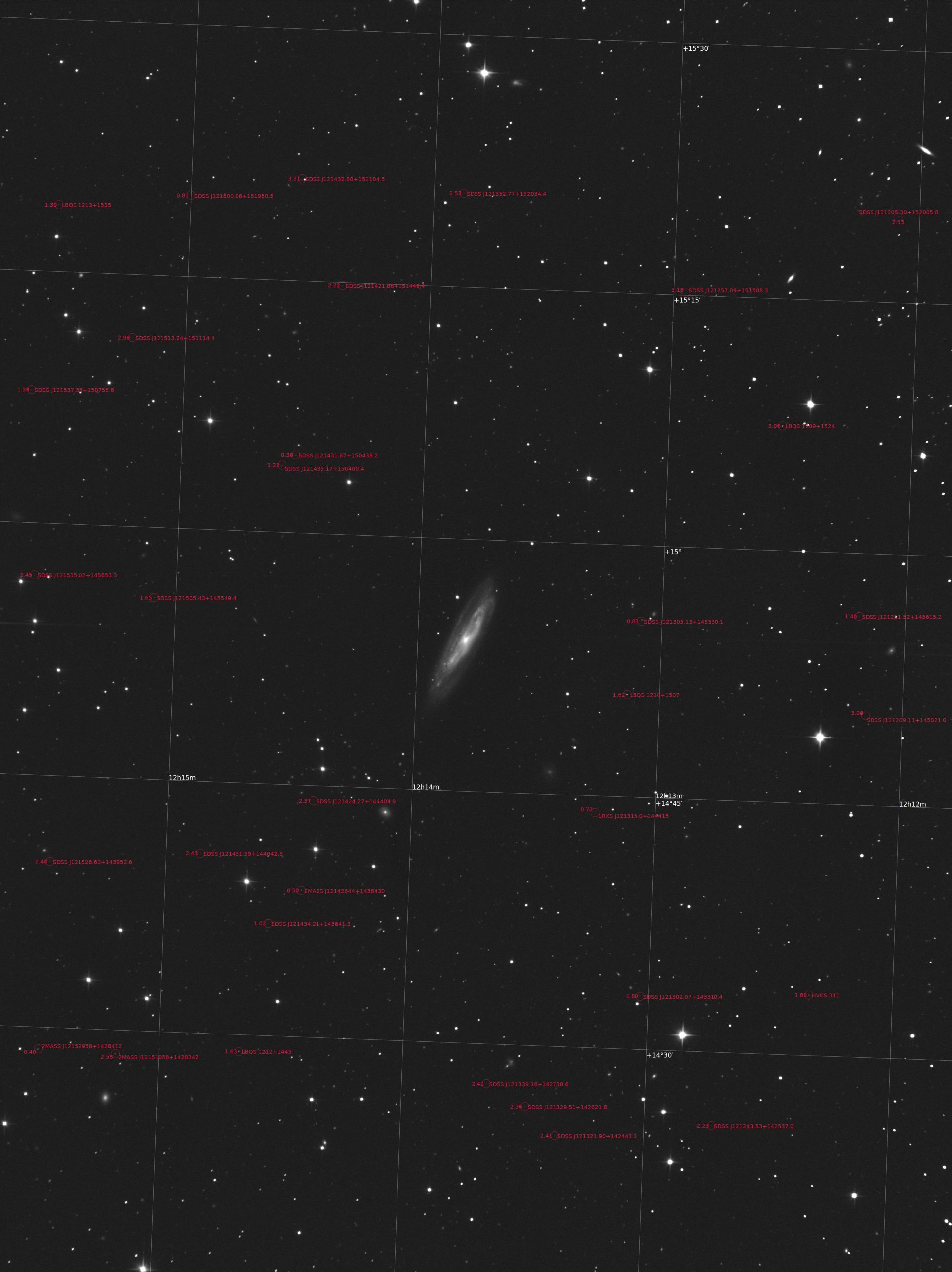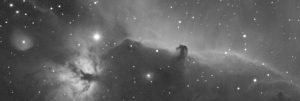20mnn exposure (L:4x300s)
Acquired on the 17th of March 2020 with 8″ ONTC
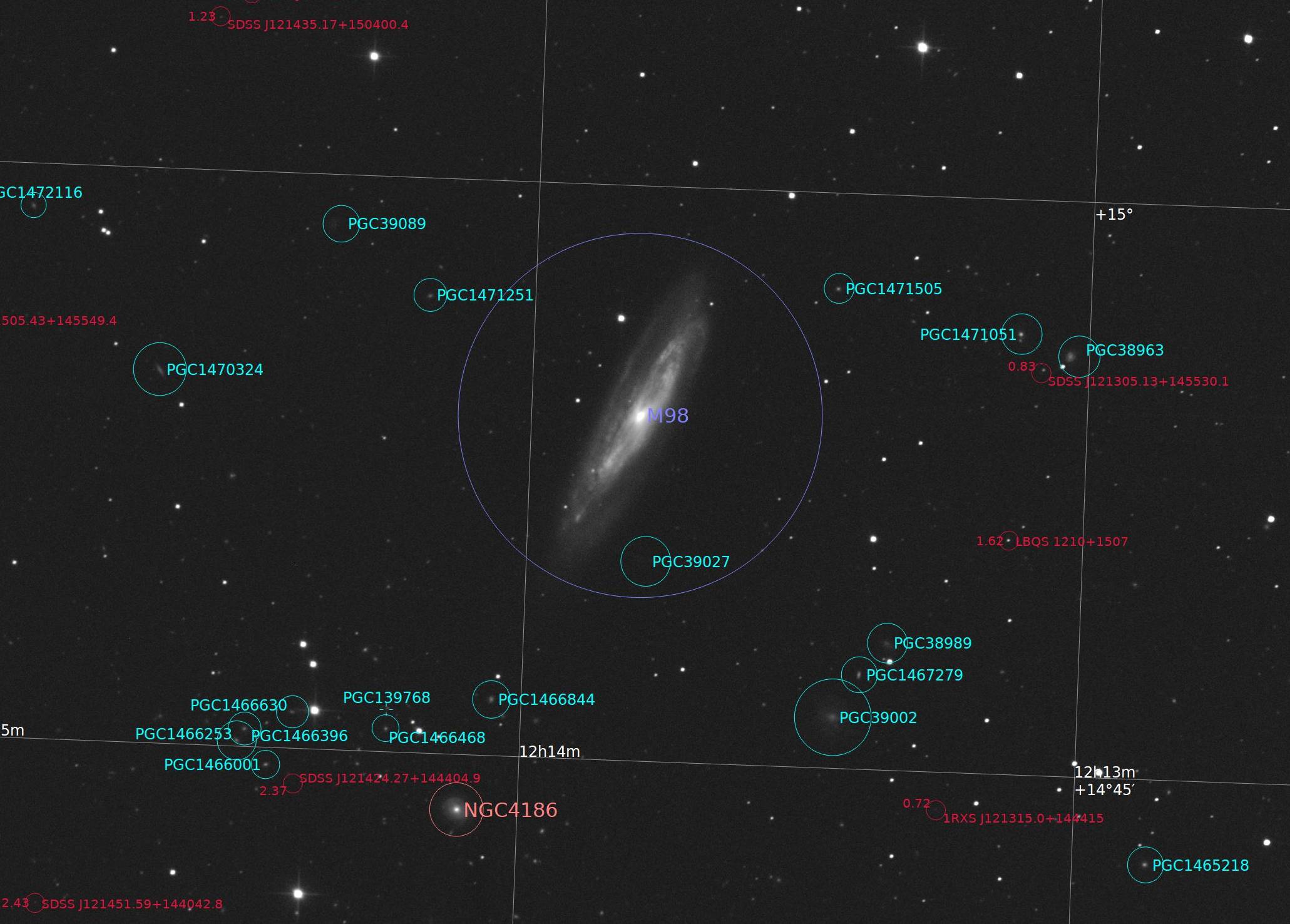
Setup: TS ONTC 200/800, 2″ Feathertouch, AZ-EQ6, QHY163m gain=100, OAG-M, QHYCFW2-M, AstroLink 4 mini. Software: APT, Stellarium, PHD2
This image is a quick capture part of a field already imaged in 2019 with Samyang 135mm lens. At this time, I was very surprised of detecting a quasar with a redshift of 3! Let’s see now what will be detected at 800mm of focal…
Location
The field of view of this image is located in Coma Berenis constellation, east of Denebola.
As mentioned above, this field of view is contained inside a wider field acquired in 2019 with a Samyang 135mm lens:
Deep sky objects
M98 is the main galaxy on this image. This is an intermediate spiral of apparent magnitude 11 located at 44 million light years. M98 is member of Virgo galaxy cluster like most of the large galaxies visible on the image above.
South of M98 lies NGC4186, a spiral galaxy of mag 13.8 located at about 360 million light years.
On the bottom of the image figure also 2 IC objects:
- IC3049, an irregular magellanic galaxy of mag 14.7 distante of 111 million light years (bottom center)
- IC3065, an elliptical dwarf galaxy of mag 13.6 located at 56 million light years (bottom center)
All others objects are much fainter and are identified as PGC. See annotated image below:
Let’s now look at quasars… 🙂
Quasars
To identify quasars, I used Aladin software to extract objects data from the field of the image. Then I solved my image under Pixinsight and annotated it with a custom catalog containing the quasars found among the extracted data.
The image below is annotated with quasars references and magnitudes in g (AB) SDSS band:
And the image below mentions redshift for each quasar:
The table hereunder lists quasars magnitudes in several bands as well as their redshifts. One column mentions also whether quasars are detected or not on the image. Detection looks possible up to mag 21 in g (AB) SDSS band!
| NAME | Detected | V (Visual) | g (AB) SDSS green | r (AB) SDSS red | Redshift |
|---|---|---|---|---|---|
| LBQS 1210+1507 | Yes | 17.661 | 17.581 | 1.61525 | |
| LBQS 1212+1445 | Yes | 17.9 | 17.937 | 17.532 | 1.62708 |
| 2MASS J12152958+1428412 | Yes | 18.38 | 18.087 | 18.086 | 0.40266 |
| LBQS 1209+1524 | Yes | 18.3 | 18.213 | 18.014 | 3.064455 |
| 2MASS J12142644+1438430 | Yes | 18.38 | 18.346 | 17.766 | 0.50167 |
| 2MASS J12151058+1428342 | Yes | 18.569 | 18.444 | 2.580123 | |
| SDSS J121505.43+145549.4 | Yes | 19.12 | 18.836 | 18.855 | 1.64868 |
| SDSS J121431.87+150438.2 | Yes | 19.27 | 18.901 | 18.608 | 0.30132 |
| LBQS 1213+1535 | Yes | 18.96 | 19.062 | 18.908 | 1.39263 |
| SDSS J121435.17+150400.4 | Yes | 19.38 | 19.168 | 18.93 | 1.23359 |
| HVCS 311 | Yes | 19.34 | 19.207 | 18.922 | 1.889859 |
| SDSS J121302.07+143310.4 | Yes | 19.74 | 19.457 | 19.456 | 1.79532 |
| SDSS J121211.52+145615.2 | Yes | 19.67 | 19.48 | 19.325 | 1.4844 |
| 1RXS J121315.0+144415 | Yes | 19.63 | 19.667 | 19.537 | 0.7164 |
| SDSS J121205.30+152005.8 | Yes | 20.01 | 19.784 | 19.712 | 2.148511 |
| SDSS J121451.59+144042.8 | Yes | 19.92 | 19.675 | 2.433529 | |
| SDSS J121528.60+143952.6 | Yes | 20.113 | 20.019 | 2.39856 | |
| SDSS J121513.24+151114.4 | Yes | 20.257 | 20.14 | 2.978001 | |
| SDSS J121243.53+142537.0 | No | 20.374 | 20.273 | 2.234359 | |
| SDSS J121321.90+142441.3 | Yes | 20.423 | 20.492 | 2.4104 | |
| SDSS J121339.16+142738.6 | Yes | 20.54 | 20.119 | 2.420823 | |
| SDSS J121535.02+145653.3 | Yes | 20.823 | 20.688 | 2.452138 | |
| SDSS J121329.51+142621.8 | Yes | 20.943 | 20.914 | 2.362041 | |
| SDSS J121434.21+143641.3 | Yes | 20.948 | 20.496 | 1.016425 | |
| SDSS J121537.55+150755.6 | Yes | 20.963 | 20.824 | 1.390774 | |
| SDSS J121500.06+151950.5 | Yes | 20.999 | 20.836 | 0.8062 | |
| SDSS J121432.80+152104.5 | No | 21.074 | 20.679 | 3.307738 | |
| SDSS J121305.13+145530.1 | No | 21.189 | 21.06 | 0.8266 | |
| SDSS J121424.27+144404.9 | No | 21.56 | 21.297 | 2.371571 | |
| SDSS J121209.11+145021.0 | No | 21.737 | 21.595 | 3.0841 | |
| SDSS J121352.77+152034.4 | No | 21.767 | 21.386 | 2.5259 | |
| SDSS J121421.86+151449.4 | No | 21.845 | 21.786 | 2.219281 | |
| SDSS J121257.09+151508.3 | No | 22.056 | 21.736 | 3.177655 |
LBQS 1209+1524 quasar
LBQS 1209+1524 is one of the quasars that was visible on the image captured one year ago with Samyang 135mm. This quasar has a redshift of 3.06 which indicates that the photons coming from it have travelled 11.5 billion years before hitting the camera CMOS sensor!
Usage of 8″ Newton confirms the detection. See image comparison below:
Conclusion
Increasing focal is obviously a big plus when it is matter to detect faint objects like quasars. For this present case, 800mm of focal lenght allows reaching mag 21 wheareas 135mm focal lenght was limited to mag 18.5. This longer focal length allows capturing LBQS 1209+1524 (mag 18.5) with a serious margin. And this is a long list of quasars which is now detected on a much narrower field.
Nevertheless, there is room for improvements with this 800mm focal length. Increasing unitary exposure (from 300s to 600s) and number of shoots will help to enhance detection. Improving collimation and tracking will also help as well…

